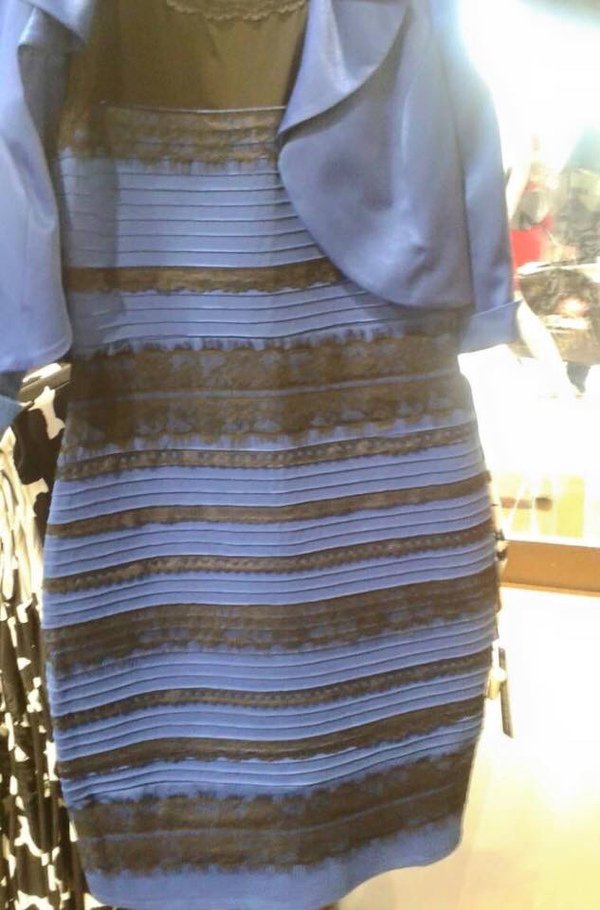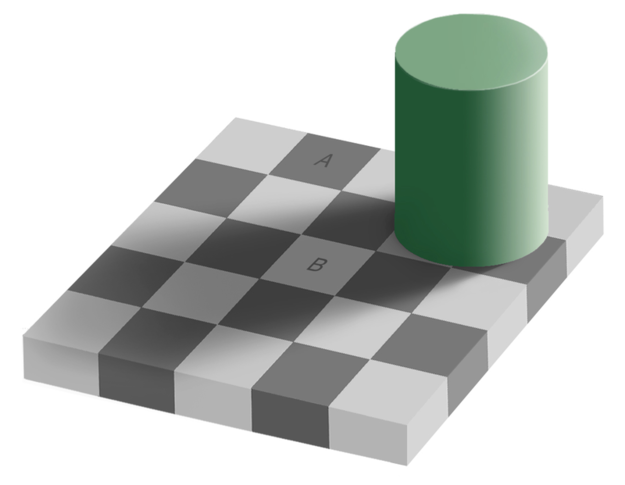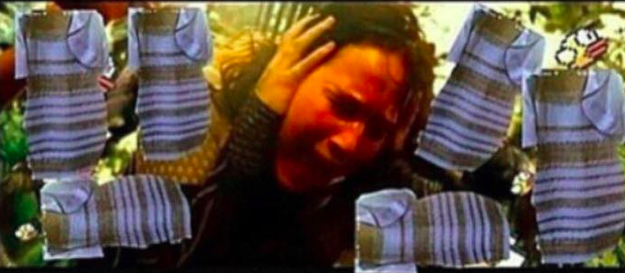Am I Completely Nuts To Be Seeing That Dress In White And Gold?!
Let science do the talking because our eyes are totally tricking us.
This photo of a dress has divided the Internet in two, those who see it as blue and black, and those who see it as white and gold
The fact that a single image could polarize the entire Internet into two aggressive camps is, let’s face it, just another Thursday.
But for the past half-day, people across social media have been arguing about whether a picture depicts a perfectly nice bodycon dress as blue with black lace fringe or white with gold lace fringe. And neither side will budge.
Before we go deeper into this colourful phenomenon, take the poll and the view results of what SAYS readers are seeing:
The social media fight over the dress was so heated that Adobe, the makers of Photoshop, had to step in to put an end to it
For those seeing #WhiteandGold in #TheDress (http://t.co/pNG9tXu5pU), @HopeTaylorPhoto ends the debate. pic.twitter.com/W7TwQJy13m
— Adobe (@Adobe) February 27, 2015
The story on Buzzfeed generated the MOST traffic in Buzzfeed history, EVER. That's huge. And it's just a dress.
More people on @buzzfeed tonight than ever before. pic.twitter.com/1kbHSjMxqs
— Ben Smith (@BuzzFeedBen) February 27, 2015
For further proof, BuzzFeed News got in touch with the original poster, Caitlin McNeill. She confirmed that the colour of the dress, having seen it herself, is actually blue and black!
So really, why are people seeing the dress in different colours? Isn't it obvious what the 'real' colours are?
The answer to that question varies.
Explanation 1: The person who took the photo either overexposed it or, most likely, adjusted it after taking it, pumping up the brightness and contrast (or shadows and lights) in her phone, which made it appear white and gold.
Explanation 2: The reason people are seeing the dress in different colours is probably it has something to do with the two different types of cells that sense light in your eyes.
Raw data courtesy of the Colour and Vision Research Laboratories (CVRL), UCL
Image via kinja-img.comYour retina is comprised of rods and cones. Rods are more sensitive to light, but see shapes and not color. Cones are sensitive to color, but less sensitive to light — i.e. in darker conditions, you're seeing more with rods than cones. You have three sizes of cones, blue (smallest) to red (biggest), as seen on the graph above.
 gizmodo.com
gizmodo.com
What determines how the dress appears to my eyes?
Whether the dress appears as blue/black or white/gold depends on whether your eye has more rods or cones, and also the ambient lighting conditions in the room. (This is thanks to the different colors that are produced by additive and subtractive color mixing.) Different people have different balances of rods and cones — most notably color-blind weirdos like myself — hence different people seeing different colors, and families brutally murdering each other over this mess.
But rods are also very sensitive to light. Rod cells detect color using a pigment called rhodopsin, which is very sensitive to low light, but is bleached and destroyed by higher light levels, and takes around 45 minutes to redevelop (why your eyes take time to adapt to night, in other words). Basically, if you look at the dress in bright light conditions, then go away for half an hour into a dark room and come back, the dress will quite probably change color.
 gizmodo.com
gizmodo.com
However, according to Wired, the actual physiology of your eye might come into play with how you perceive the dress
According to Neitz, an individual’s lens, which is part of the eyeball, changes over the course of one’s lifespan. Individuals are less sensitive to blue light when they are older. Which could explain why older netizens are seeing white and gold. But, in the absence of hard-core data relating to age and perceptions regarding the dress, this theory cannot be proved yet.
At the same time, the way the dress is captured on camera could also be playing a significant role in this debate. According to Science Daily, humans are blessed with something called color constancy, which means that while color should be easily identifiable whether you’re in bright or dull lighting, things can change if the lighting is colored.
So it's about how my brain is interpreting the light coming into my eyes? Yeah, as BuzzFeed explains:
“We are always making decisions about the quantity of light that comes into our retina,” Riener said. This light, called luminance, is always a combination of how much light is shining on an object and how much it reflects off of the object’s surface, he added.
“In the case of the dress, some people are deciding that there is a fair amount of illumination on a blue and black (or less reflective) dress. Other people are deciding that it is less illumination on a white/gold dress (it is in shadow, but more reflective).”
This is just like the famous Adelson checkerboard optical illusion. In the image below, square A is exactly the same shade as square B, but they look totally different:
But why is my brain interpreting the light differently than that of, say, my friend?
Our vision is heavily influenced by so-called “top-down” processing, John Borghi, a cognitive neuroscientist at Rockefeller University, told BuzzFeed News. Top-down processing “begins with the brain and flows down, filtering information through our experience and expectations to produce perceptions.”
Each person brings a different set of experiences and expectations, as well as attention levels and particular eye movements. For example, what you looked at just before you looked at the dress could influence the way your brain perceived it, Borghi added. “It could also be that you’ve seen dresses (or fabric) with the same texture or shape before, which could also affect your perception.” This general phenomenon is called priming.
Interestingly, scientists don’t know much about individual differences in perception, Riener said.
“The individual differences tend not to receive as much attention from perceptual researchers, since we focus on how eyes work in general,” he said. “And in general, our eyes work very similarly, since we all live in an environment where the color of the light is generally the same shade of blue.”
In the image here, WIRED explains that the places some people see as blue do indeed track as blue. But, it probably has more to do with the background than the actual colour.
“Look at your RGB values. R 93, G 76, B 50. If you just looked at those numbers and tried to predict what color that was, what would you say?” Conway asks.
So…kind of orange-y?
“Right,” says Conway. “But you’re doing this very bad trick, which is projecting those patches on a white background. Show that same patch on a neutral black background and I bet it would appear orange.” He ran it through Photoshop, too, and now figures that the dress is actually blue and orange. The point is, your brain tries to interpolate a kind of color context for the image, and then spits out an answer for the color of the dress.
So when context varies, so will people's visual perception
The original image is in the middle. At left, white-balanced as if the dress is white-gold. At right, white-balanced to blue-black!
Image via wired.com“Most people will see the blue on the white background as blue,” Conway says. “But on the black background some might see it as white.” He even speculated, perhaps jokingly, that the white-gold prejudice favors the idea of seeing the dress under strong daylight. “I bet night owls are more likely to see it as blue-black,” Conway says.
In conclusion, if you are seeing the dress in blue and black:
You are seeing it for what it is. The dress is actually blue and black. As BuzzFeed notes, "you're not easily deceived and haven't got time for bullshit. You're no-nonsense and probably smarter than everyone else. You are to the point, stoic, and understanding. You have no time for the frivolous nature of "gold and white" lovers. The world is a real place, and you see things the way they really are."
However, if you are seeing the dress in white and gold:
"You’re imaginative and creative. You’re not bound by “reality” and know there’s more to things than meets the eye. You’re wrong about a lot of things, but your headstrong nature sees you often convince people otherwise. For you, it’s all about attitude."






